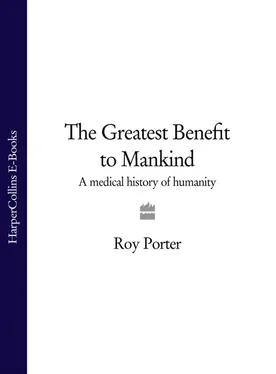The Old Testament records the epidemics the Lord hurled upon the Egypt of the pharaohs, and from Greek times historians noted their melancholy toll. The Peloponnesian War of 431 to 404 BC, the ‘world war’ between Athens and Sparta, spotlights the traffic in pestilence that came with civilization. Before that war the Greeks had suffered from malaria and probably tuberculosis, diphtheria and influenza, but they had been spared truly calamitous plagues. Reputedly beginning in Africa and spreading to Persia, an unknown epidemic hit Greece in 430 BC, and its impact on Athens was portrayed by Thucydides (460 – after 404 BC). Victims were poleaxed by headaches, coughing, vomiting, chest pains and convulsions. Their bodies became reddish or livid, with blisters and ulcers; the malady often descended into the bowels before death spared sufferers further misery. The Greek historian thought it killed a quarter of the Athenian troops, persisting on the mainland for a further four years and annihilating a similar proportion of the population.
What was it? Smallpox, plague, measles, typhus, ergotism and even syphilis have been proposed in a parlour game played by epidemiologists. Whatever it was, by killing or immunizing them, it destroyed the Greeks’ ability to host it and, proving too virulent for its own good, the disease disappeared. With it passed the great age of Athens. Most early nations probably experienced such disasters, but Greece alone had a Thucydides to record it.
Epidemics worsened with the rise of Rome. With victories in Macedonia and Greece (146 BC), Persia (64 BC) and finally Egypt (30 BC), the Roman legions vanquished much of the known world, but deadly pathogens were thus given free passage around the empire, spreading to the Eternal City itself. The first serious outbreak, the so-called Antonine plague (probably smallpox which had smouldered in Africa or Asia before being brought back from the Near East by Roman troops) slew a quarter of the inhabitants in stricken areas between AD 165 and 180, some five million people in all. A second, between AD 211 and 266, reportedly destroyed some 5,000 a day in Rome at its height, while scourging the countryside as well. The virulence was immense because populations had no resistance. Smallpox and measles had joined the Mediterranean epidemiological melting-pot, alongside the endemic malaria.
Wherever it struck a virgin population, measles too proved lethal. There are some recent and well-documented instances of such strikes. In his Observations Made During the Epidemic of Measles on the Faroe Islands in the Year 1846, Peter Panum (1820–85) reported how measles had attacked about 6,100 out of 7,864 inhabitants on a remote island which had been completely free of the disease for sixty-five years. In the nineteenth century, high mortality was also reported in measles epidemics occurring in virgin soil populations (‘island laboratories’) in the Pacific Ocean: 40,000 deaths in a population of 150,000 in Hawaii in 1848, 20,000 (perhaps a quarter of the population) on Fiji in 1874.
Improving communications also widened disease basins in the Middle East, the Indian subcontinent, South Asia and the Far East. Take Japan: before AD 552, the archipelago had apparently escaped the epidemics blighting the Chinese mainland. In that year, Buddhist missionaries visited the Japanese court, and shortly afterwards smallpox broke out. In 585 there was a further eruption of either smallpox or measles. Following centuries brought waves of epidemics every three or four years, the most significant being smallpox, measles, influenza, mumps and dysentery.
This alteration of occasional epidemic diseases into endemic ones typical of childhood – it mirrors the domestication of animals – represents a crucial stage in disease ecology. Cities buffeted by lethal epidemics which killed or immunized so many that the pathogens themselves disappeared for lack of hosts, eventually became big enough to house sufficient non-immune individuals to retain the diseases permanently; for this an annual case total of something in the region of 5,000–40,000 may be necessary. Measles, smallpox and chickenpox turned into childhood ailments which affected the young less severely and conferred immunity to future attacks.
The process marks an epidemiological watershed. Through such evolutionary adaptations – epidemic diseases turning endemic – expanding populations accommodated and surmounted certain once-lethal pestilences. Yet they remained exposed to other dire infections, against which humans were to continue immunologically defenceless, because they were essentially diseases not of humans but of animals. One such is bubonic plague, which has struck humans with appalling ferocity whenever populations have been caught up in a disease net involving rats, fleas and the plague bacillus ( Yersinia pestis ). Diseases like plague, malaria, yellow fever, and others with animal reservoirs are uniquely difficult to control.
Bubonic plague is basically a rodent problem. It strikes humans when infected fleas, failing to find a living rat once a rat host has been killed, pick a human instead. When the flea bites its new host, the bacillus enters the bloodstream. Filtered through the nearest lymph node, it leads to the characteristic swelling (bubo) in the neck, groin or armpit. Bubonic plague rapidly kills up to two-thirds of those infected. There are two other even more fatal forms: septicaemic and, deadliest of all, pneumonic plague, which doesn’t even need an insect vector, spreading from person to person directly via the breath.
The first documented bubonic plague outbreak occurred, predictably enough, in the Roman empire. The plague of Justinian originated in Egypt in AD 540; two years later it devastated Constantinople, going on to massacre up to a quarter of the eastern Mediterranean population, before spreading to western Europe and ricocheting around the Mediterranean for the next two centuries. Panic, disorder and murder reigned in the streets of Constantinople, wrote the historian Procopius: up to 10,000 people died each day, until there was no place to put the corpses. When this bout of plague ended, 40 per cent of the city’s population was dead.
It was the subsequent plague cycle, however, which made the greatest impact. Towards 1300 the Black Death began to rampage through Asia before sweeping westwards through the Middle East to North Africa and Europe. Between 1346 and 1350 Europe alone lost perhaps twenty million to the disease. And this pandemic was just the first wave of a bubonic pestilence that raged until about 1800 (see Chapter 5).
Trade, war and empire have always sped disease transmission between populations, a dramatic instance being offered by early modern Spain. The cosmopolitan Iberians became subjects of a natural Darwinian experiment, for their Atlantic and Mediterranean seaports served as clearing-houses for swarms of diseases converging from Africa, Asia and the Americas. Survival in this hazardous environment necessitated becoming hyper-immune, weathering a hail of childhood diseases – smallpox, measles, diphtheria, gastrointestinal infections and other afflictions rare today in the West. The Spanish conquistadores who invaded the Americas were, by consequence, immunological supermen, infinitely more deadly than ‘typhoid Mary’; disease gave them a fatal superiority over the defenceless native populations they invaded.
Though the Black Death ebbed away from Europe, war and the movements of migrants ensured that epidemic disease did not go away, and Spain, as one of the great crossroads, formed a flashpoint of disease. Late in 1489, in its assault on Granada, Islam’s last Iberian stronghold, Spain hired some mercenaries who had lately been in Cyprus fighting the Ottomans. Soon after their arrival, Spanish troops began to go down with a disease never before encountered and possessing the brute virulence typical of new infections: typhus. It had probably emerged in the Near East during the Crusades before entering Europe where Christian and Muslim armies clashed.
Читать дальше












